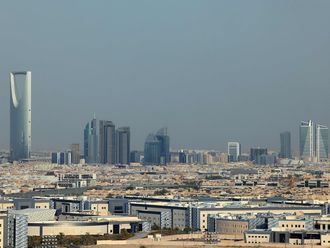
Put the terms geopolitics and oil in the same sentence, and generally speaking the discussion will be referring to an escalation or spike in prices, as uncertainty over delivery creates a market premium.
It is ironic, then, in a week when the world’s strategic flashpoints only grew in their emphasis -- Iraq and Ukraine, most evidently -- that oil prices should break out of their unusually well-established range on the downside.
Some media outlets even foraged into their verbal toolkit to refer to plummeting, while the decline has been historically modest still, in the single digits, not to mention keeping the benchmark Brent series due north of $100 a barrel.
That exaggeration need not disguise underlying concerns for the industry in the Gulf.
A report by KPMG’s Global Energy Institute (GEI) published this year described changes in oil markets “having a profound effect on energy relationships”, particularly the growth of unconventional oil and gas production in North America, impacting upon Gulf exports, also the prime investment opportunities being there (or in Russia), as well as the “complementarity of objectives” with Asian importing countries, one that is likely to promote large-scale tie-ups.
“GCC producers are increasingly interested in energy investments that do more than produce energy,” according to the research, owing to the strain placed on their economic systems by the budgetary pressures arising since the Arab Spring, and the demographics otherwise driving unemployment.
Startlingly, the GEI observed that “from 1970 to 2011 GCC per capita income in real terms declined, from approximately US$40,000 to US$28,000.” Thus, the race might appear to be on to reverse a receding wealth and welfare tide. Moreover, pumping more oil and gas to remedy budget stress not only poses technical challenges, but has to compete with the growth in domestic demand, averaging some 6 per cent per year.
The recurrent influence of geopolitics remains elemental to Gulf economics because of oil’s own special, even overriding importance to the region’s economies, as is readily understood.
In its monthly series of economic reports, late last year GIC affirmed the point by pooling various data models, investigating the relationship between oil price dynamics and economic growth, government revenues and fiscal balances, besides exports and imports.
Empirical queries
The so-called elasticity of oil revenues to changes in oil prices is close to 1.0, i.e. a “one-to-one relationship between prices and revenues” in the GCC states. By extension, the elasticity of economic growth, whilst inevitably positively connected to oil prices, “varies between 0.3 and 0.5”. Meanwhile, the impact of oil exports on the fiscal account is “appreciable”, while “empirical queries suggest that the impact of oil prices on exports is powerful, with an elasticity of 1.1, while imports tend to be adversely related to [prices]”.
In a recent paper IMF analyst Serhan Cevik (IMF) explained how the oil sector has continued to determine the Gulf’s economic cycles, but differentially so across the GCC states, despite their similar economic endowments and institutional structures.
While hydrocarbons still account for “an overwhelming share” of export earnings and fiscal receipts, “leading to a higher degree of business cycle synchronicity at an aggregate level, this is driven largely by external factors influencing the price of crude oil and natural gas”, the study pointedly determined, rather than regional influences.
The share of non-hydrocarbon sectors has increased over time, from about 55 per cent of GDP in 2000 to some 62 per cent by 2010, but their co-movement declined and was comparatively low.
It is partly because of divergent fiscal policies, Cevik found. While oil and gas predominate, “the extent of discretionary policy reaction functions vary greatly”. Of course, “this is not an unexpected finding, since government’s consumption and fixed investment spending account for almost 32 per cent of GDP, and over 47 per cent of non-hydrocarbon GDP, on average.”
Intra-regional trade
Its policy implications, though, are that the GCC countries tend to be exposed to asymmetric shocks from the rest of the world, whose spillovers “are far more important than regional inter-linkages in explaining cyclical fluctuations”.
The limited level of intra-regional trade and financial integration also “certainly contribute” to business cycle desynchronization.
Despite a free trade area being in place since 1983 and a custom union since 2003, the
share of intra-regional trade is less than 5 per cent of total trade, compared with the EU’s figure of over 70 per cent, and NAFTA’s of around 50 per cent.
Incidentally, the basic finding of this statistical testing – of significant differences in non-hydrocarbon business cycles -- happens to mean that “the GCC countries do not appear to be an optimum currency area, and the cost of a monetary union may outweigh its benefits.”
That’s a serious issue in itself. At the same time, it’s useful to know, admit and underline that trends in the regional economy remain so highly dependent on what’s going on elsewhere, internationally.











